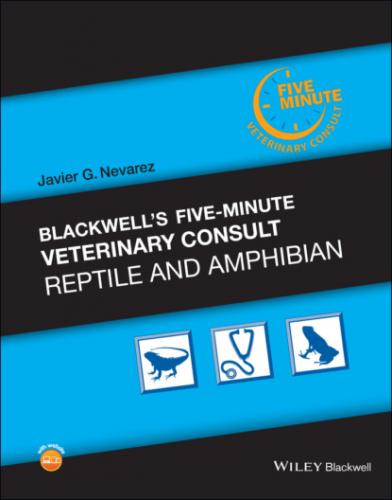SURGICAL CONSIDERATIONS
Surgery is best performed before stasis progresses while the animal is metabolically stable.
Surgery should be an immediate consideration for chelonians with documented chronic stasis, metabolic derangements, and when egg yolk coelomitis is suspected.
The goal of surgery is to remove the follicles and perform an ovariectomy, to avoid reoccurrence.
Follicular stasis is commonly associated with follicles on both ovaries but even if only one is affected, bilateral ovariectomy is recommended.
Extreme care must be taken to not rupture the follicles in the coelomic cavity, as the
Follicular Stasis
yolk is extremely antigenic and will cause a severe inflammatory response.
If leakage occurs, the coelomic cavity should be thoroughly lavaged before closure.
DRUG(S) OF CHOICE
Calcium: start with calcium gluconate (100 mg/kg IM, SC q12–24h) followed by calcium glubionate (10–100 mg/kg PO q4–24h) long term
Magnesium: magnesium sulfate 20 mg/kg IM, SC q24–72h or magnesium lactate (Rescue Cal+, Repashy Ventures, CA) 20 mg/kg PO q24h
Crystalloid fluids: 20–30 ml/kg SC, IV q24h
Meloxicam: 0.5 mg/kg PO, IM, SC q24–48h
Morphine: 1–10 mg/kg IM, SC q24h
Hydromorphone: 0.2–0.5 mg/kg IM, SC q12–24h
PRECAUTIONS/INTERACTIONS
Morphine and hydromorphone can cause sedation and respiratory depression.
Dose and frequency of administration should be refined based on the patient’s response.
PATIENT MONITORING
If performing medical therapy alone, the weight of the chelonian should be recorded daily to every other day to provide an early indication that follicle atresia may be occurring.
Any acute weight losses beyond 10% of the body weight should prompt re‐evaluation by a veterinarian.
If an underlying disease process was diagnosed, appropriate follow‐up diagnostics should be performed to determine improvement of that condition or the need to alter therapy.
For those undergoing surgery, a re‐evaluation with 1–2 weeks is recommended to evaluate the surgical site and overall recovery.
EXPECTED COURSE AND PROGNOSIS
Ultimately, the prognosis will depend on the underlying cause of follicular stasis and the required therapy.
Cases with underlying infectious or metabolic disease that respond to medical therapy have a good prognosis.
Many cases requiring surgical therapy have a good to guarded prognosis.
COMMENTS
The ultimate diagnosis of follicular stasis is based on interpretation of clinical signs, history, and results of physical exam and diagnostics.
Before ovariectomy is performed, it is essential to have at least one confirmatory test that there are indeed follicles present in the coelomic cavity.
It must be mentioned that the sex of the animals must be confirmed as female before surgery is performed.
While this may seem obvious, in some chelonians species sex determination can be quite challenging, especially when of small size, and males may present with coelomic neoplasias or GI obstructions that clinically appear very similar to follicular stasis.
ZOONOTIC POTENTIAL
N/A
SYNONYMS
Preovulatory follicular stasis
ABBREVIATIONS
Ca = calcium
CBC = complete blood count
CT scan = computed tomography
GI = gastrointestinal
IM = intramuscular
Mg = magnesium
MRI = magnetic resonance imaging
NSHP = nutritional secondary hyperparathyroidism
P = phosphorus
PO = per os
SC = subcutaneous
UVB = ultraviolet B
Suggested Reading
1 Chitty J, Raftery A. Follicular stasis. In: Chitty J, Raftery A, eds. Essentials of tortoise medicine and surgery. Oxford, UK: Wiley Blackwell; 2003:200–204.
2 Jacobson ER. Overview of reptile biology, anatomy, and histology. In: Jacobson ER, ed. Infectious Diseases and Pathology of Reptiles: Color Atlas and Text. Boca Raton, FL: CRC Press; 2007:14–17.
3 McArthur S. Problem‐solving approach to common diseases of terrestrial and semiaquatic chelonians. In: McArthur S, Wilkinson R, Meyer J, eds. Medicine and Surgery of Tortoises and Turtles. Ames, IA: Blackwell; 2004:309–378.
Author Javier G. Nevarez, DVM, PhD, DACZM, DECZM (Herpetology)
Gout
DEFINITION/OVERVIEW
Gout is a common disease seen in reptiles, which occurs due to the buildup of uric acid crystals deposited in or around the joints or throughout visceral organs.
ETIOLOGY/PATHOPHYSIOLOGY
Increased production of uric acid may occur due to excessive levels of dietary proteins, or potentially due to an inherited enzyme defect as occurs in humans.
Excretion may be compromised, for example by dehydration, starvation, nephrotoxic drugs, or renal pathology.
Uric acid is a relatively insoluble substance so when levels are elevated in the blood or in other body fluids, crystallization will occur and deposits will form.
Uric acid crystals may deposit in the joints (articular gout), around the joints (periarticular gout) or throughout other internal organs (visceral gout).
Common sites for visceral
